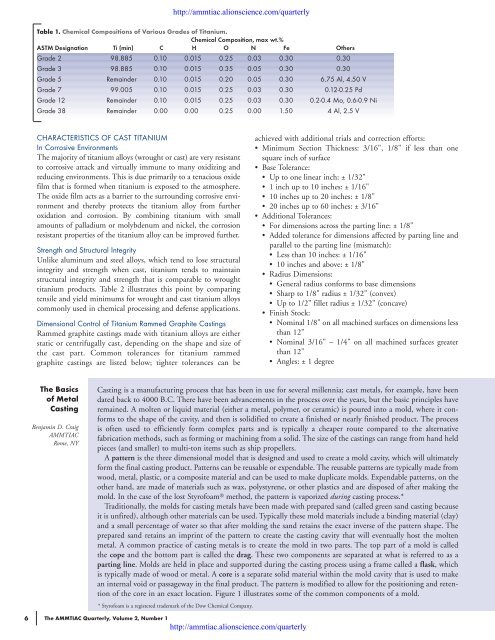AMMTIAC Quarterly, Vol. 2, No. 1 - Advanced Materials ...
AMMTIAC Quarterly, Vol. 2, No. 1 - Advanced Materials ...
AMMTIAC Quarterly, Vol. 2, No. 1 - Advanced Materials ...
- No tags were found...
Create successful ePaper yourself
Turn your PDF publications into a flip-book with our unique Google optimized e-Paper software.
Table 1. Chemical Compositions of Various Grades of Titanium.Chemical Composition, max wt.%ASTM Designation Ti (min) C H O N Fe OthersGrade 2 98.885 0.10 0.015 0.25 0.03 0.30 0.30Grade 3 98.885 0.10 0.015 0.35 0.05 0.30 0.30Grade 5 Remainder 0.10 0.015 0.20 0.05 0.30 6.75 Al, 4.50 VGrade 7 99.005 0.10 0.015 0.25 0.03 0.30 0.12-0.25 PdGrade 12 Remainder 0.10 0.015 0.25 0.03 0.30 0.2-0.4 Mo, 0.6-0.9 NiGrade 38 Remainder 0.00 0.00 0.25 0.00 1.50 4 Al, 2.5 VCHARACTERISTICS OF CAST TITANIUMIn Corrosive EnvironmentsThe majority of titanium alloys (wrought or cast) are very resistantto corrosive attack and virtually immune to many oxidizing andreducing environments. This is due primarily to a tenacious oxidefilm that is formed when titanium is exposed to the atmosphere.The oxide film acts as a barrier to the surrounding corrosive environmentand thereby protects the titanium alloy from furtheroxidation and corrosion. By combining titanium with smallamounts of palladium or molybdenum and nickel, the corrosionresistant properties of the titanium alloy can be improved further.Strength and Structural IntegrityUnlike aluminum and steel alloys, which tend to lose structuralintegrity and strength when cast, titanium tends to maintainstructural integrity and strength that is comparable to wroughttitanium products. Table 2 illustrates this point by comparingtensile and yield minimums for wrought and cast titanium alloyscommonly used in chemical processing and defense applications.Dimensional Control of Titanium Rammed Graphite CastingsRammed graphite castings made with titanium alloys are eitherstatic or centrifugally cast, depending on the shape and size ofthe cast part. Common tolerances for titanium rammedgraphite castings are listed below; tighter tolerances can beachieved with additional trials and correction efforts:• Minimum Section Thickness: 3/16", 1/8" if less than onesquare inch of surface• Base Tolerance:• Up to one linear inch: ± 1/32"• 1 inch up to 10 inches: ± 1/16"• 10 inches up to 20 inches: ± 1/8"• 20 inches up to 60 inches: ± 3/16"• Additional Tolerances:• For dimensions across the parting line: ± 1/8"• Added tolerance for dimensions affected by parting line andparallel to the parting line (mismatch):• Less than 10 inches: ± 1/16"• 10 inches and above: ± 1/8"• Radius Dimensions:• General radius conforms to base dimensions• Sharp to 1/8" radius ± 1/32" (convex)• Up to 1/2" fillet radius ± 1/32" (concave)• Finish Stock:• <strong>No</strong>minal 1/8" on all machined surfaces on dimensions lessthan 12"• <strong>No</strong>minal 3/16" – 1/4" on all machined surfaces greaterthan 12"• Angles: ± 1 degreeThe Basicsof MetalCastingBenjamin D. Craig<strong>AMMTIAC</strong>Rome, NYCasting is a manufacturing process that has been in use for several millennia; cast metals, for example, have beendated back to 4000 B.C. There have been advancements in the process over the years, but the basic principles haveremained. A molten or liquid material (either a metal, polymer, or ceramic) is poured into a mold, where it conformsto the shape of the cavity, and then is solidified to create a finished or nearly finished product. The processis often used to efficiently form complex parts and is typically a cheaper route compared to the alternativefabrication methods, such as forming or machining from a solid. The size of the castings can range from hand heldpieces (and smaller) to multi-ton items such as ship propellers.A pattern is the three dimensional model that is designed and used to create a mold cavity, which will ultimatelyform the final casting product. Patterns can be reusable or expendable. The reusable patterns are typically made fromwood, metal, plastic, or a composite material and can be used to make duplicate molds. Expendable patterns, on theother hand, are made of materials such as wax, polystyrene, or other plastics and are disposed of after making themold. In the case of the lost Styrofoam ® method, the pattern is vaporized during casting process.*Traditionally, the molds for casting metals have been made with prepared sand (called green sand casting becauseit is unfired), although other materials can be used. Typically these mold materials include a binding material (clay)and a small percentage of water so that after molding the sand retains the exact inverse of the pattern shape. Theprepared sand retains an imprint of the pattern to create the casting cavity that will eventually host the moltenmetal. A common practice of casting metals is to create the mold in two parts. The top part of a mold is calledthe cope and the bottom part is called the drag. These two components are separated at what is referred to as aparting line. Molds are held in place and supported during the casting process using a frame called a flask, whichis typically made of wood or metal. A core is a separate solid material within the mold cavity that is used to makean internal void or passageway in the final product. The pattern is modified to allow for the positioning and retentionof the core in an exact location. Figure 1 illustrates some of the common components of a mold.* Styrofoam is a registered trademark of the Dow Chemical Company.6The <strong>AMMTIAC</strong> <strong>Quarterly</strong>, <strong>Vol</strong>ume 2, Number 1

















